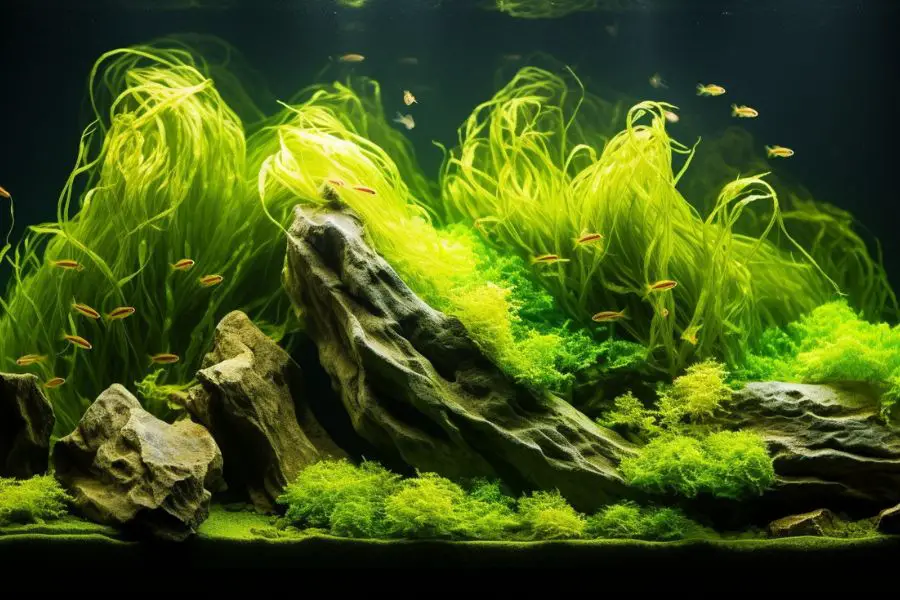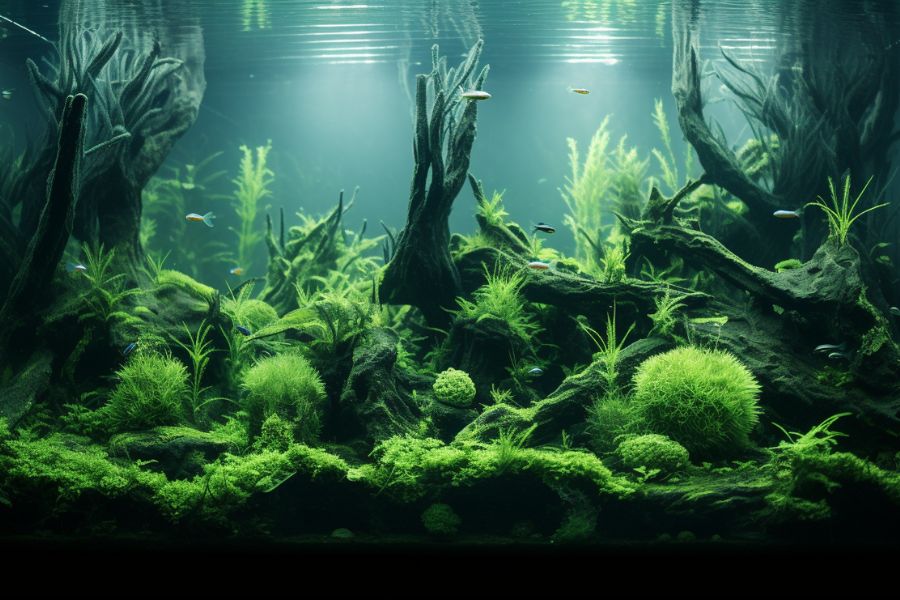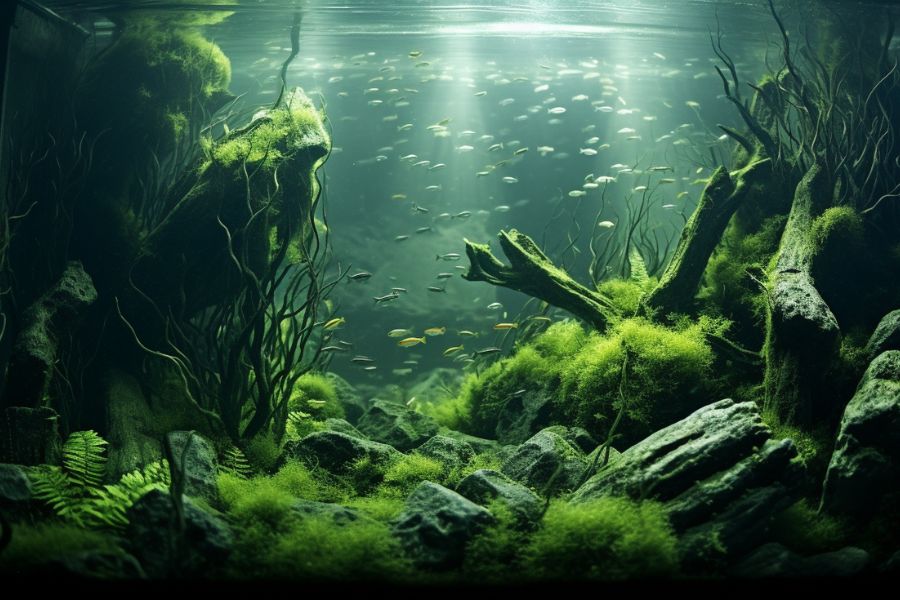Algae Problem After New Light is a common and frustrating side effect when enthusiasts upgrade their aquarium lighting.

Seeking to spotlight fish colors or grow lusher plants, hobbyists invest in higher intensity bulbs or LED fixtures. But without adjustments, all that new light energy feeds massive algae overgrowths.
Getting the balance right takes trial and error, but a few key countermeasures can tip the scales back in favor of crystal clear water.
Why Light Drives Algae Growth
Jump To
Light powers photosynthesis, allowing green algae to multiply and spread. Standard aquarium bulbs provide only moderate illumination suitable for easy low-light plants.
This keeps algae in check. But upgrades to LED, metal halides, or compact fluorescents dramatically boost the light energy penetrating the tank.
Sudden intense lighting overloads allow algae to leverage their explosive growth capabilities. Given the right conditions, single celled algae can divide every few hours.
Doubling and redoubling their populations creates visible blooms within days after new lights are installed.
Tank owners seeking to illuminate aquascapes or boost plant growth get far more than they bargained for if the lighting level is not increased gradually. Too much light too fast is a recipe for algae domination.
Types of Algae Taking Advantage
While all algae benefit from stronger light, a few notorious types become especially troublesome after upgrades:
- Green water algae – Microscopic floating algae turning water murky green
- Hair algae – Tough strands up to several inches long waving from plants
- Black beard algae – Dense black tufts smothering plants and decor
- Brown diatoms – Fast-spreading brown coating on leaves and glass
- Blue-green algae – Slick cyanobacterial colonies choking plants
These aggressive varieties leverage the added illumination to shut down plants and overwhelm the tank.
Established algae pockets explode into bloom overnight. Once entrenched, they are extremely difficult to eliminate.

Strategies to Combat Post-Upgrade Algae
Taking a multi-pronged approach is key to getting the new lighting upgrade under control before algae domination is complete. Useful techniques include:
1. Reduce Photoperiod
Shorten the number of hours the lights are on each day, down to just 6-8 hours maximum. This limits the fuel driving algae growth. Use timers to enforce the schedule.
2. Block Light Penetration
Cut down the intensity reaching lower levels by floating plants, adding shade screens, or positioning tall decor to cast shadows. This removes lower-tank real estate from the algae growth zone.
3. Remove Algae Manually
Do weekly 25% water changes and use algae scrapers, cloths, and siphon suction to mechanically strip away as much algae as possible. This resets the growth clock.
4. Increase Plant Density
Fill in all open spaces with fast-growing stem plants. Floaters like hornwort or duckweed also help shade out algae. This allows plants to outcompete algae for nutrients and light access.
5. Use Algae-Eating Crews
Stock algae eaters like otocinclus, nerite snails, Amano shrimp, and rabbit snails. Their appetites provide natural algae control between manual removals.
6. Dose Liquid Carbon
Addings a carbon source for plants like Excel or EasyCarbo at dosing above recommendations helps starve algae of carbon while fertilizing plants.
7. Adjust Fertilizer Levels
Cutting back on nitrogen and phosphate in ferts prevents feeding algae. But continue potassium and micros to strengthen plants. Find the leanest balance through testing.
8. Install UV Sterilization
A UV clarifier kills free-floating algae, greatly reducing green water events. Use in combination with other efforts targeting rooted algae types.
With persistence, algae will eventually retreat in the face of these combined counter-tactics. The key is staying vigilant.
Long-Term Lighting Adjustments for Algae Control
Once the initial algae onslaught is under control through active removal and limitation, lighting levels can be gradually tuned to find an optimal balance.
- Slowly increase duration – Add 30-60 minutes per week back to the photoperiod until algae begins growing again. Then cut back to the highest sustainable duration.
- Raise intensity gradually – Increase LED brightness no more than 10% increments over several weeks. Pause if algae appears.
- Use separate intensity zones – Leverage hanging lights to create brighter areas just above target plant zones, not the whole tank.
- Maintain floating plants – Keep umbrella plantings that restrict light penetration without compromising plant health below.
- Use timers – Set lights to ramp up and down over 30-60 minutes to simulate natural cycles. Avoid abrupt on/off transitions.
- Clean regularly – Wipe off any new algae growth quickly before it establishes. Vigilance is essential.
With careful incremental adjustments, balance can be achieved where plants thrive under sufficient light while algae remains choked off.
But hobbyists must be prepared to play the long game in this struggle toward equilibrium. Don’t give up! An algae-free high-light tank can absolutely be attained through persistence.

Why did I get an algae bloom right after replacing my old fluorescent light with an LED light?
The new LED light is likely much brighter and providing more intensity than your tank’s balance can handle. This fuels rapid algae growth. You’ll need to gradually acclimate the tank to the new lighting level.
I scrubbed all the algae off but it keeps coming back within a few days. What should I do?Manual removal only buys you a little time. To get long-term control, you need to address limiting light exposure along with fertilizer levels, plant density, and algae eaters to outcompete the algae.
Is a UV sterilizer a quick fix for the green water algae after my light upgrade?
UV clarifiers only target green water algae. They won’t help with hair algae, diatoms etc. Think of them as just one tool among many to use in combination against algae.
How long do I need to leave the new lights off entirely to reset the tank after an algae outbreak?
3-5 days of a total blackout helps reset the tank. Then slowly increase the photoperiod by 30 mins per week when restarting lights.
Should I reduce or increase fertilizer dosing to stop the new light from growing more algae?
Reduce, especially phosphates and nitrogen. Fertilize just enough to support plants but not feed the algae competitively. Finding the lean point takes trial and error.
Why is my tank still getting algae even though I reduced the photoperiod after the new light?
Your light is probably still too intense for the shortened duration. Try blocking off some light penetration or raising the fixture higher above the tank to reduce intensity.
How heavily should I plant the tank to prevent future algae issues with the new LED light?
Very heavily! Shoot for at least 70% of the tank floor space covered in fast growing stems. Floaters like hornwort also really help block light penetration to algae.
If I cut back plant fertilizers to control algae, how do I know what level is sufficient for the plants?
Watch plant health closely and look for any deficiency symptoms. Yellowing, stunting, or spotty leaves indicates reducing fertilizer too far. Increase again slowly.
Read Next:
Battling Persistent High Nitrates in Freshwater Aquariums
Do Bottled Bacteria Really Boost Your Aquarium Cycle?
